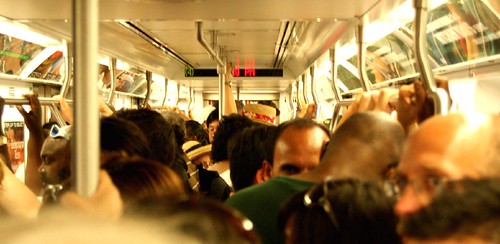I’m going to do something I don’t do too often in this space: I’m going to rant about the way the MTA handles train transfers at stations with island platforms. Here we go.
On Tuesday, when I was on the way back to Brooklyn from work, I took a B from West 4th St. to DeKalb where I would switch to an M or R to take me to Union St. and my gym. Usually, it’s a pretty quick ride; during rush hour, I can get a B to DeKalb or a D to Pacific St. and the M/R trains usually show up after a few minutes’ wait.
Tuesday was no exception. As the B pulled into DeKalb, the R train was sitting across the platform with the doors open seemingly waiting for connecting passengers. The B did its usually crawl into DeKalb, and we sat for a beat before the doors open. The entire time we sat there, the R had been posed, doors open awaiting passengers.
When the doors to the B finally opened, the doors to the R slammed shut. All of us waiting for that train — the Bay Ridge-bound passengers and the folks looking for stops in between — were denied our connection. It was an inexplicable move by the MTA. Why bother holding the doors to the R open just to close them when the passengers on the B finally decamp from their train?
A few minutes later, an M showed up to whisk us south through Brooklyn, and I was soon at Union St., the incident largely forgotten for most of the people who were stymied by the R. I however couldn’t help but think about that R train. How many times have we seen this happen? Whether it’s at Broadway and Lafayette on the BMT IND or W. 72nd St. on the IRT, trains will routinely close their doors right as a train on the adjacent platform pulls up. Frustrated passengers are left staring at lights receding down the tunnel while their desired transfer heads off into the distance.
It wouldn’t be too hard to or too inconvenient for train operators to hold their doors and extra 10 or 15 seconds at major transfer points. It wouldn’t throw off the train schedules, and it wouldn’t create back-ups in the tunnels. It would create good will and positive feelings from other passengers, and that is something the MTA could sorely use these days.

 When the MTA, in December, announced plans to add more line managers and, seemingly, another layer of bureaucracy to an overburdened agency, I noted that the leadership were
When the MTA, in December, announced plans to add more line managers and, seemingly, another layer of bureaucracy to an overburdened agency, I noted that the leadership were 

 After years of strained labor relations, the MTA and the TWU Local 100, the labor union for all the city’s transit workers, are finally working to improve their labor relations. With another round of contract talks due later this year, a panel led by former MTA Chair Richard Ravitch and Hezekiah Brown issued a report late last week that pinpointed 61 ways the MTA and the TWU can work to improve their relationship.
After years of strained labor relations, the MTA and the TWU Local 100, the labor union for all the city’s transit workers, are finally working to improve their labor relations. With another round of contract talks due later this year, a panel led by former MTA Chair Richard Ravitch and Hezekiah Brown issued a report late last week that pinpointed 61 ways the MTA and the TWU can work to improve their relationship. Earlier this morning, I introduced the Permanent Citizens Adivsory Committee’s
Earlier this morning, I introduced the Permanent Citizens Adivsory Committee’s  When it comes to subways, the concept of “on time” is a rather amorphous one. Most New Yorkers would consider the subway to be on a time if a train were pulling into a station and getting ready to open its doors right as we were making our way down (or up) the staircase to the platform. In reality — pesky thing that — the folks who run subways have a stricter definition of “on time” that even involves some schedules, and according to recent reports, New York is faring pretty well with that “on time” thing.
When it comes to subways, the concept of “on time” is a rather amorphous one. Most New Yorkers would consider the subway to be on a time if a train were pulling into a station and getting ready to open its doors right as we were making our way down (or up) the staircase to the platform. In reality — pesky thing that — the folks who run subways have a stricter definition of “on time” that even involves some schedules, and according to recent reports, New York is faring pretty well with that “on time” thing.